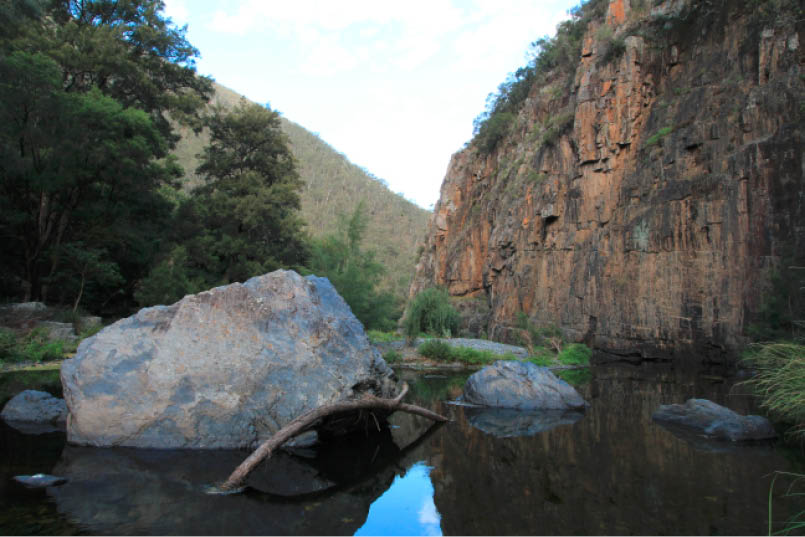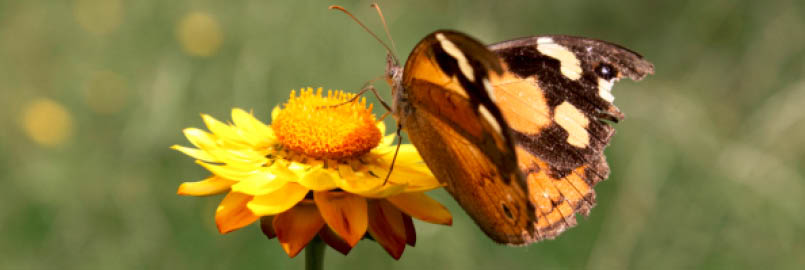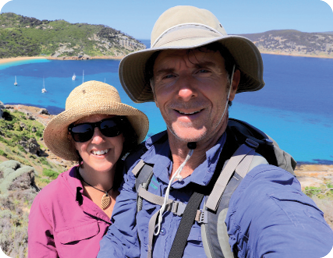

A five day walk in 2018 turns into a quest to explain the unexplainable.
The rugged depths of Tia GorgeAll photos by Craig Fardell

The Butterfly Effect
Chris Armstrong

18 | BWA June 2020


Black Jezebel
I’m lying on a cool rock in a shady, rainforest gully and there are butterflies in the air – a constant stream of them, zooming overhead, all disappearing downstream as more arrive from upstream. After half an hour, the butterflies become so numerous and persistent I decide to try to count them.
I ask my partner Craig to time 30 seconds on his watch. I count butterflies that fly directly over my prone body. At times, it is impossible to keep up with the sheer numbers. But, in 30 seconds I count 40 butterflies.
As I watch, one catches in a spider web and is quickly bundled up in silk as the rest of the swarm continue on their erratic way. I am mesmerised by this crowd of beauty in what is a remarkably remote, anonymous part of the country. Craig and I are on a five day wilderness adventure, exploring a remote section of the Apsley River, deep in the 120,000 hectares of Oxley Wild Rivers National Park in NSW. It is day two
but, because of a summer heat wave, we stopped walking at 12:30 pm and wandered into this cool grotto, tucked off the main river. As we entered, an endangered brush-tailed rock wallaby scampered quickly into the depths of the hills. But the butterflies are the main surprise. All of them are the same; golden brown with a spot pattern on each wing.
To beat the heat, we stay in the gully for three hours. All the while, the butterflies continue unabated. I do the basic maths - 40 butterflies, 30 seconds, 3 hours. At least 14,400 butterflies pass over my head. My estimate is grossly conservative, as the entire gully is full of them and they are still coming, even as we leave.
I am no lepidopterist but I realise we are witnessing something special. What I don’t know, until more than six months later, is just how rare these hours are.
BWA June 2020 | 19

Apsley River at the junction with Tia Gorge
The walkAs I drag my hot, tired body out of that cool gorge, my main focus is simply surviving the walk. The country and the weather have thrown us huge challenges. There are no tracks to follow and the terrain is rugged. It has turned hotter than expected; too hot to sleep in the tent at night. Instead, we bed down in the open air, lying in our underwear as live bait for mosquitoes. Each night I wake many times, fretful with bites. Each morning the alarm goes off at 5 am. To beat the heat, we are walking by 6:30 am. It is a gruelling regime and one we follow for the entire five days. By lunch each day, exposed river stones and bed-rock are too hot to rest on. At the end of one day I write in my journal: “Can’t do anything, just sit and swim, and stare. We hardly talk.”
It is, however, undeniably beautiful country. We clamber through mini-gorges, pass small cascades and are refreshed by deep, cool swimming holes. On our last night, the campsite is as idyllic as it gets — nestled at the junction of the Tia and Apsley Rivers beside a two metre stepped cascade replete with water slide and more rock wallabies. We even finally get a reprieve from the heat — a
night still too hot for tent or sleeping bags until I wake at midnight and southwards, downstream, I see lightning. Above me, the stars are lovely and I wish upon them for relief and at some stage, fall asleep again. I wake twice more - each time clouds appear above, lightning continues. I sleep again. I wake again. This time, I feel rain drops. Groggy with fatigue, I call out to Craig. It is nearly midnight as we fumble with the tent. Blinding lightning is followed by a great crash of thunder. Rain pelts down. The tent is up. I grab rocks to hold each corner. Craig grabs our packs and dives in under the tent fly. The lightning and thunder is formidable and the whole melee lasts an hour. Once the worst of it passes, we do a better job of pitching the tent, crawl back inside, put on dry clothes and sleep — immediately and deeply until the alarm goes off at 5 am. Then we begin climbing out to the farmland above. It is a stunning finish to a tumultuous few days. Cloud rises out of the river valley as we skirt Tia Gorge and arrive back at our car.
Yet none of it beats the memory of lying in that shady gully — the cool rocks beneath my hot skin, the green rainforest canopy, the butterflies.
20 | BWA June 2020

Common Brown
What did we see?On returning home, I gush about them to anyone who will listen; giving long, impassioned descriptions of the sheer numbers on that magical afternoon. I also spend fruitless hours online, hoping to find information about similar gatherings of butterflies in Australia. I contact the local University of New England for a more professional, informed understanding of what we witnessed. The university refers me to butterfly enthusiasts, Carol and Trevor Deane in Dorrigo.
Craig and I drive to the Deane’s conservation property on the edge of the plateau. It is a beautiful block of land surrounded by rainforest and rich in butterfly food plants. Sitting on their back deck, with cups of tea and biscuits at hand, we relate our story in more detail. They ask simple straightforward questions that I can barely answer. My lack of observational skills is appalling. I am embarrassed.
Did we get any photos? Well no, the butterflies were small and agile and Craig only had a wide-angle lens. I explain how my attention was drawn to the butterflies when I saw one caught in a spider’s web. Trevor asks: did you get the wings out of the web for identification? I never thought of doing that. He explains how it would be helpful if we could pinpoint the particular butterfly and he hands me his butterfly field guide. It is packed with a bewildering range of gold brown butterflies with distinctive spot patterns. Just one small spot can mean a different species. We struggle to choose any of them.*
The pair describe what we saw as a butterfly migration, a phenomenon they say is not well understood and rarely studied. Perhaps
the most famous migrating butterfly is the Monarch butterfly in North America — which leaves its late summer breeding grounds in north-eastern U.S. and Canada and travels over 4500 kilometres to reach overwintering grounds on the west coast of California or mountainous sites in Central Mexico. The butterflies return north the following spring to mate and lay their eggs.
There are over a dozen Australian butterflies known to migrate including the Caper White Butterfly (Belenois java), Lemon Migrant (Catopsilia pomona) and the Painted Lady (Vanessa kershawi). The Painted Lady in New South Wales has been known to migrate on a front that extends for about 580 kilometres inland from the coast. This migration can continue for up to eight weeks, with the main movement being in a south to south-westerly direction. In 1889, they were reported to migrate in such great numbers that they blackened the sky. Trains were unable to get traction because so many butterflies were resting on the tracks. Such mass migrations have not been reported for some time.
Scientists are also yet to discover if two way migrations do also occur in Australia. Butterflies are tricky things to follow. Consequently, when it comes to butterfly migrations, there are many unknowns. Trevor and Carol explain that sightings like ours could be at the start, the middle or the end of a migration. They could be migrating for food or moving for temperature.
“What triggers them to "wait" and band together and then commence a mass flight in a particular direction I don't believe is understood,” Trevor said. “It would be nice to study migration but you need a lot of time and resources. A drone in your back pocket would be handy.”
BWA June 2020 | 21

Butterflies at riskThe sheer lack of information on Australian butterflies and their movements is one of science’s greatest challenges. In the Atlas of Living Australia - a digital, open access database of Australian plants and animals - there are currently less than 250,000 sighting records for butterflies, compared to 40 million for birds. Yet, there are about 440 butterfly species in Australia. Eight are currently listed as threatened but as many as 38 are potentially under threat of extinction.
Carol and Trevor, as expert citizen scientists, are part of a conservation team studying two of Australia’s most endangered species, the Australian Fritillary Butterfly and the Southern Pink Underwing Moth. The moth is found from Bellingen Shire north to southern Queensland. The Fritillary butterfly is also local, found in open swampy coastal areas where the larval food plant Arrowhead Violet (Viola betonicifolia) occurs. It is known from a few widespread localities between Port Macquarie and Gympie, but populations have declined dramatically and unfortunately, there have been no confirmed sightings since 2001.
“It has never been a common butterfly. Both have also been seriously affected by habitat alteration since white settlement. We have almost got to the end of that because I think the Fritillary is probably extinct,” Trevor says. “It is just so fruitless. You’ve got to wait for somebody, like you, walking out there, who sees it.”
Learning how to seeUnfortunately, we now know the problem with that strategy. I have quickly learnt that “seeing” is one thing but “observing” is quite another. In his seminal work Arctic Dreams, the American nature writer Barry Lopez writes: “It not only takes a long time of watching the animal before you can say what it is doing; it takes a long time to learn how to watch.”
I say to Carol and Trevor, that I would love to go back to our gully at the same time next year, hoping we might see it all again and do a better job of witnessing. But, again, migrations of Australian butterfly species are not so well known or predictable.
“There is nothing to say it wouldn’t happen but migrations appear random,” Trevor explains. “Maybe at times there is one in successive years but you may be waiting 8, 10, 15 years.”
Despite us showing ourselves to be flawed observers, Carol and Trevor are generous with their time and knowledge. They celebrate our butterfly experience with us with Carol giving a genuine, simple summary of the importance of it all, saying finally: “But, what a lovely thing to witness.”
*From our description, and historic records of migrations, the pair think the most likely species we saw was either the Meadow Argus or the Painted Lady. Using their field guide, our memory of colour and shape we felt the butterflies most resembled the Meadow Argus.
You can help Just this year, the Australian National University launched a new butterflies app, aimed at encouraging people to record sightings. The app is free to download and includes a field guide with basic information about how to identify every species of butterfly in Australia. See Butterflies Australia.
Chris and Craig are a bit like butterflies - they wander around the Australian bush, migrating to where the walking is good. They blog about their adventures at Awildland. Carol and Trevor Deane curate a fabulous butterfly website Butterflies of a Dorrigo garden.

22 | BWA June 2020